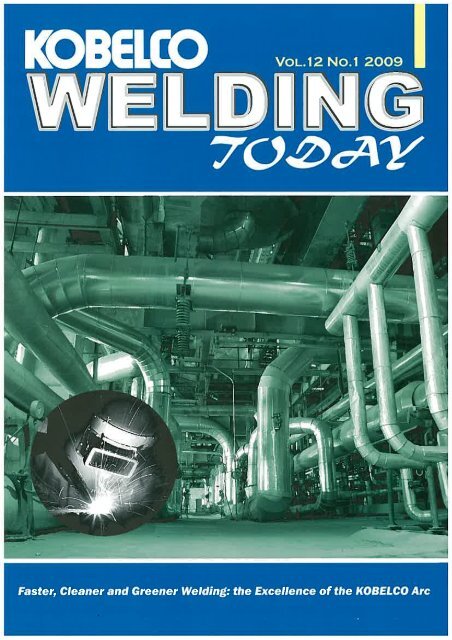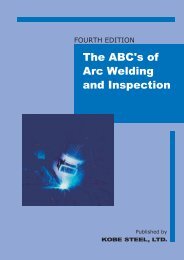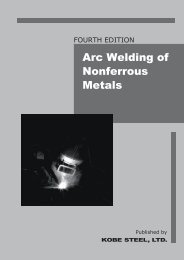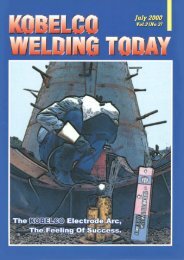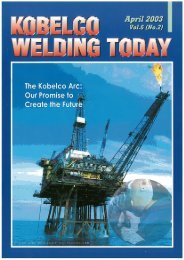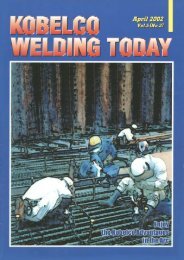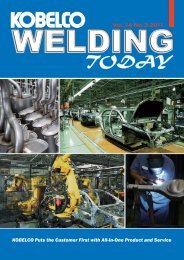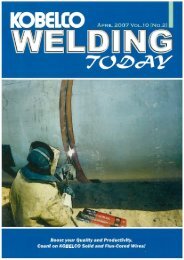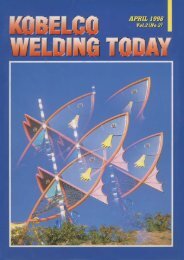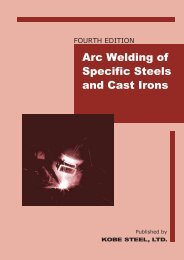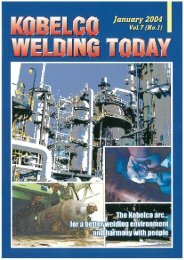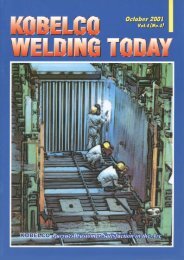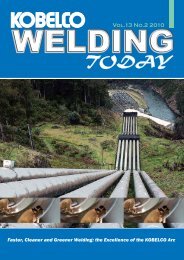Kobelco Welding Today Vol.12 No.1 2009
Kobelco Welding Today Vol.12 No.1 2009
Kobelco Welding Today Vol.12 No.1 2009
You also want an ePaper? Increase the reach of your titles
YUMPU automatically turns print PDFs into web optimized ePapers that Google loves.
Products Spotlight<br />
KOBELCO WELDING TODAY <strong>Vol.12</strong> <strong>No.1</strong><br />
<br />
<br />
<br />
<br />
Increased efficiency in coal-fired power generation<br />
has reduced that industry’s consumption of fuels,<br />
thereby decreasing carbon dioxide emissions associated<br />
with global warming. In a related trend, high<br />
performance steels have been developed to resist<br />
the increased temperatures and pressures of steam<br />
in the boilers. W-enhanced 9-12Cr steels (such as<br />
ASME P92 and P122) are now regarded as stateof-the-art<br />
high-Cr ferritic steels that are superior to<br />
9Cr-1Mo-V-Nb steel (typically ASME P91) in<br />
creep rupture strength.<br />
To accommodate this grade of steel, Kobe Steel<br />
has developed CR-12S for shielded metal arc<br />
welding and TG-S12CRS for gas tungsten arc<br />
welding. Tables 1 and 2 show the unique chemical<br />
compositions and excellent mechanical properties<br />
of these filler metals.<br />
Table 1: Chemical compositions of CR-12S deposited metal<br />
and TG-S12CRS wire<br />
Trade<br />
designation<br />
CR-12S<br />
TG-S12CRS<br />
Size 4.0mmØ 1.6mmØ<br />
Sampling Deposited metal Wire<br />
Polarity AC*1 DCEP*2 DCEN<br />
C% 0.08 0.08 0.07<br />
Si% 0.36 0.35 0.35<br />
Mn% 1.01 0.97 0.74<br />
P% 0.007 0.007 0.004<br />
S% 0.002 0.002 0.003<br />
Ni% 0.49 0.51 0.51<br />
Co% 1.58 1.61 1.01<br />
Cr% 9.83 9.77 9.92<br />
Mo% 0.24 0.25 0.35<br />
Nb% 0.032 0.030 0.04<br />
V% 0.35 0.36 0.21<br />
W% 1.63 1.64 1.45<br />
Cu 0.02 0.02 0.01<br />
Creq *3<br />
7.55 7.43 8.40<br />
1. <strong>Welding</strong> current: 160A; <strong>Welding</strong> position: flat.<br />
2. <strong>Welding</strong> current: 140A; <strong>Welding</strong> position: flat.<br />
3. Creq = Cr+6Si+4Mo+1.5W+11V+5Nb+1.2Sol.Al+8Ti–40C–2Mn–<br />
4Ni–2Co–30N–Cu (mass%)<br />
Table 2: Mechanical properties of CR-12S deposited metal<br />
and TG-S12CRS weld metal at room temperature*1<br />
Trade designation CR-12S TG-S12CRS<br />
Size 4.0mmØ 1.6mmØ<br />
Polarity AC*2 DCEP*3 DCEN<br />
0.2%PS (MPa)*4 648 652 686<br />
TS (MPa)*4 768 771 790<br />
El (%)*4 26 25 23<br />
RA (%)*4 64 68 68<br />
2vE (J) at 0°C*5 40 60 44<br />
PWHT<br />
740°C × 8h FC<br />
1. <strong>Welding</strong> conditions in GTAW: Base metal: (F) SUS410J3 per the<br />
Thermal Power Technical Standard of Japan; Shielding gas: Ar.<br />
2. <strong>Welding</strong> current: 160A; Heat input: 12kJ/cm; Preheat & interpass<br />
temperature: 200-250°C; <strong>Welding</strong> position: flat.<br />
3. <strong>Welding</strong> current: 140A; Heat input: 18kJ/cm; Preheat & interpass<br />
temperature: 200-250°C; <strong>Welding</strong> position: flat.<br />
4. Test specimen (JIS Z 3111, Type A2): 6.0mmØ, G.L: 24mm.<br />
5. Average for three specimens (JIS Z 3111 Type 4)<br />
The chemical compositions of CR-12S and TG-<br />
12CRS are designed with the proper chromium<br />
equivalent (Creq) so as to minimize the precipitation<br />
of delta ferrite in the martensitic matrix,<br />
thereby assuring sufficient impact toughness and<br />
creep rupture strength.<br />
Typical applications for these filler metals include<br />
headers and main steam pipes in supercritical pressure<br />
boilers and ultra-supercritical pressure boilers<br />
which operate at higher temperatures and pressures<br />
as compared with conventional boilers.<br />
Figure 1: Main steam pipes (left) and a header (right) in position<br />
connected with a bundle of tubes. (Source: Mitsubishi<br />
Heavy Industries, Ltd. and National Institute of Materials Science,<br />
Japan)<br />
1
Preface<br />
KOBELCO WELDING TODAY <strong>Vol.12</strong> <strong>No.1</strong><br />
Expecting a fruitful business recovery<br />
after overcoming the worldwide financial crisis<br />
Since Lehman Brothers, a US investment bank, went bankrupt in September last<br />
year, triggering a “once-in-a-hundred-years” global economic recession, the seriousness<br />
of the slump has only continued to grow. Japanese industry has not avoided economic<br />
hardship, with those enterprises dependent on exports being hit doubly hard<br />
from a decrease in sales as well as appreciation of the Japanese yen. Leading automobile<br />
and electronics manufacturers have announced that large losses are to be expected<br />
as they settle their accounts at the end of the financial year. Even though the major<br />
industrialized countries agreed on measures to boost economies and stabilize finances,<br />
conditions worldwide have only worsened, with financial turmoil accelerating and<br />
stock prices falling everywhere.<br />
In an environment such as this, Kobe Steel must also be prepared for a severe fiscal<br />
year in <strong>2009</strong> and aim at securing the highest sales possible while also strengthening<br />
<strong>Kobelco</strong>’s overseas foothold by fortifying the company's financial and business position.<br />
However, as “necessity is the mother of invention,” innovation may now be more<br />
forthcoming during this period of adversity than in times of economic boom. We are<br />
aware that, in <strong>2009</strong>, all employees must be crisis-conscious, work out new plans with<br />
originality and ingenuity and push innovation forward to build a basis for the company's<br />
future prosperity and stronger business structure.<br />
In newly emerging countries, many brand new enterprises have achieved No. 1 status<br />
within their particular arenas. These global challengers tend to have a characteristic<br />
business strategy that emphasizes at least one or two of the following points.<br />
1) Achieving competitive cost performance<br />
2) Investing in human resources<br />
3) Penetrating deeply into target markets<br />
4) Adopting a pinpoint marketing strategy<br />
5) Being ambitious and swift when entering foreign markets<br />
6) Innovating with originality and ingenuity (Investing amply in research and development<br />
in order to supply innovative products)<br />
7) Accepting market pluralism (Responding flexibly to differences in customers'<br />
needs and distribution structures)<br />
The <strong>Kobelco</strong> <strong>Welding</strong> Company Group is also a global industry with nine footholds<br />
overseas, and we intend to formulate strategies that are tailored to fit the needs of the<br />
main industries in such fields as automobile manufacturing, shipbuilding or energy<br />
development. The article in these pages on the welding of equipment related to power<br />
boilers demonstrates our awareness that in China, India and Brazil there is steady<br />
demand for improvement of infrastructure. The article promotes our “only one in the<br />
world” product and provides technical support to our customers.<br />
It is our sincere hope that we will overcome the present business difficulties and<br />
prosper together with our customers. We hope that you will extend your support and<br />
help us to further popularize the <strong>Kobelco</strong> brand throughout the world.<br />
<br />
<br />
<br />
P1<br />
Shining in the welding of<br />
super and ultra super critical<br />
pressure boilers<br />
P3-7<br />
Heat-resistant high-Cr<br />
ferritic steel welding<br />
consumables for boilers<br />
<br />
<br />
<br />
P8<br />
Creep rupture strength is<br />
essential for heat-resisting<br />
steels and filler metals<br />
Toshiyuki Okuzumi<br />
General Manager<br />
International Operations Dept.<br />
<strong>Welding</strong> Company<br />
Kobe Steel, Ltd.<br />
P9-10<br />
Celebrating<br />
the anniversaries of<br />
TKW (40), KMWT (20)<br />
and KWS (30)<br />
2
Technical Highlight<br />
KOBELCO WELDING TODAY <strong>Vol.12</strong> <strong>No.1</strong><br />
<br />
<br />
<br />
<br />
<br />
Thermal electric power generated from fossil fuels<br />
such as coal and oil satisfies around 50% of the<br />
world’s total demand for electric energy. The challenge<br />
for the thermal electric power industry has<br />
been to improve power generation efficiency in<br />
order to reduce costs as well as carbon dioxide<br />
emissions. Power generation efficiency can be<br />
improved by increasing the steam temperature and<br />
pressure in the power generating turbines. Figure 1<br />
shows how steam temperature and pressure has<br />
been increasing in recent years in thermal electric<br />
power boilers in Japan. Research into ultrasupercritical<br />
pressure power plants that operate<br />
with steam heated to a temperature of 650°C and<br />
pressurized to 34MPa has also been increasing.<br />
<br />
<br />
<br />
<br />
<br />
<br />
<br />
<br />
<br />
<br />
<br />
<br />
<br />
<br />
<br />
<br />
<br />
<br />
<br />
<br />
<br />
<br />
<br />
<br />
<br />
<br />
<br />
<br />
<br />
<br />
<br />
<br />
<br />
Figure 1: Increases in steam temperature and pressure for<br />
thermal electric power boilers in Japan.<br />
The structural materials used in high-temperature<br />
high-pressure steam boilers must be able to withstand<br />
severe conditions for long periods of operation.<br />
Creep rupture strength that is adequate at<br />
elevated temperatures over long service periods is<br />
essential, and thermal fatigue resistance is important<br />
to accommodate the variations in operating<br />
conditions caused by system shutdown and startup<br />
as well as variable loads in day and night operations.<br />
To meet such stringent requirements, heatresistant<br />
high-Cr (9-12Cr) ferritic steels (P91, P92<br />
and P122) have been developed. For example,<br />
Modified 9Cr-1Mo (9Cr-1Mo-V-Nb) steel (P91)<br />
has been used in many thermal electric power boilers<br />
around the world for two decades. This article<br />
introduces a line of 9-12Cr ferritic steel filler metals<br />
for thermal electric power boilers.<br />
Varieties of 9-12Cr ferritic steels<br />
Research into heat-resistant ferritic as well as<br />
austenitic steels has been on-going for many years.<br />
Heat-resistant ferritic steel is characterized by a<br />
lower thermal expansion coefficient as compared<br />
with heat-resistant austenitic steel, giving it more<br />
resistance to temperature fluctuations caused by<br />
variable operation conditions and shutdowns, and<br />
is thus more suitable for the structural materials in<br />
thermal power boilers. For heat resistant steels<br />
used in these applications, the most important<br />
property is creep rupture strength. When steel is<br />
maintained under a certain amount of stress at an<br />
elevated temperature for a long time, it becomes<br />
susceptible to creep rupture, even if the stress is<br />
lower than the ultimate tensile strength. Because<br />
the creep rupture strength of heat resistant steels<br />
can actually govern the lifetime of power boilers,<br />
the development of heat resistant steels with higher<br />
creep rupture strength has been a research priority.<br />
Figure 2 illustrates the development of heat resistant<br />
ferritic steels in conjunction with improvements<br />
in creep rupture strength. There are three<br />
main streams in ferritic steel development: 2.25Cr-<br />
1Mo steel, 9Cr-1Mo steel and 12Cr steel. By adding<br />
carbide precipitation strengthening elements<br />
such as Nb and V or solid solution hardening elements<br />
such as Mo and W, the creep rupture<br />
strength of these steels has been improved. Lately,<br />
newer ferritic steels have been developed by not<br />
3
Technical Highlight<br />
KOBELCO WELDING TODAY <strong>Vol.12</strong> <strong>No.1</strong><br />
only adjusting the chemical composition but also<br />
adopting new heat treatment and rolling processes.<br />
Table 1 shows typical chemical compositions of 9-<br />
12Cr ferritic steels.<br />
Table 1: Typical chemical compositions of heat-resistant 9-<br />
12Cr ferritic steels (mass%)<br />
Type of steel 9Cr-1Mo-V-Nb W-enhanced 9-12Cr<br />
ASME std. T91 T92 T122<br />
C 0.10 0.07 0.11<br />
Si 0.4 0.06 0.1<br />
Mn 0.45 0.45 0.60<br />
Cr 9.0 9.0 12.0<br />
Mo 1.0 0.5 0.4<br />
W - 1.8 2.0<br />
Cu - - 1.0<br />
V 0.20 0.20 0.20<br />
Nb 0.08 0.05 0.06<br />
B - 0.004 0.003<br />
N 0.05 0.06 0.06<br />
9-12Cr ferritic steel filler metals<br />
Filler metals for welding 9-12Cr ferritic steels are<br />
required to possess comparable creep rupture<br />
strength and impact toughness as the base metal.<br />
The weld metal with a relatively coarse grain<br />
microstructure must be able to meet the mechanical<br />
requirements of postweld heat treatment<br />
(PWHT) at a temperature lower than the tempering<br />
temperature for the steel. This is why the filler<br />
metal must be designed with an elaborate chemical<br />
composition different from that of the steel to satisfy<br />
the conflicting properties of creep rupture and<br />
impact toughness. Thus, whereas the properties of<br />
such steels can be tailored not only chemically but<br />
also thermomechanically, by rolling and applying<br />
special heat treatment (quenching and tempering),<br />
the properties of the filler metals can only be<br />
adjusted chemically. The following paragraphs<br />
will introduce those filler metals tailored for welding<br />
9Cr-1Mo-V-Nb steel and W-enhanced 9-12Cr<br />
steels.<br />
Filler metals for 9Cr-1Mo-V-Nb steel<br />
Table 2 shows the typical chemical and mechanical<br />
properties of the <strong>Kobelco</strong> filler metals for 9Cr-<br />
1Mo-V-Nb steel. Certain elements in the chemical<br />
composition of the weld metal differs from that of<br />
the steel. Firstly, the carbon content of the weld<br />
metal is lower; this is to control the hardenability<br />
of the weld metal, thereby obtaining the proper<br />
strength, ductility, toughness, and sufficient crack<br />
resistance. The weld metal is also characterized by<br />
higher amounts of manganese and nickel to restrict<br />
δ -ferrite precipitation in the microstructure,<br />
thereby ensuring better impact toughness.<br />
<br />
<br />
<br />
<br />
<br />
<br />
<br />
<br />
<br />
<br />
<br />
<br />
<br />
<br />
<br />
<br />
<br />
<br />
<br />
<br />
<br />
<br />
<br />
<br />
<br />
<br />
<br />
<br />
<br />
<br />
<br />
<br />
<br />
<br />
<br />
<br />
<br />
<br />
<br />
<br />
<br />
<br />
<br />
<br />
<br />
<br />
<br />
<br />
<br />
<br />
<br />
Figure 2: Development of heat-resistant low-alloy steels for thermal electric power boilers<br />
in conjunction with improvement of creep rupture strength.<br />
<br />
<br />
<br />
<br />
<br />
<br />
4
Technical Highlight<br />
KOBELCO WELDING TODAY <strong>Vol.12</strong> <strong>No.1</strong><br />
Table 2: Typical chemical and mechanical properties of<br />
TRUSTARC filler metals for 9Cr-1Mo-V-Nb steel*1<br />
<strong>Welding</strong> process SMAW GTAW GMAW SAW<br />
Trade designation CM-9Cb TG-S9Cb MG-S9Cb PF-200S/<br />
US-9Cb<br />
AWS classification A5.5<br />
E9016-G<br />
A5.28<br />
ER90S-G<br />
A5.28<br />
ER90S-G<br />
A5.23<br />
F10PZ-<br />
C% 0.06 0.08 0.08 0.06<br />
Si% 0.31 0.16 0.35 0.12<br />
Mn% 1.51 1.01 1.59 1.58<br />
P% 0.006 0.006 0.007 0.008<br />
S% 0.003 0.005 0.008 0.004<br />
Ni% 0.94 0.71 0.45 0.55<br />
Cr% 9.11 9.01 8.79 8.31<br />
Mo% 1.06 0.90 0.88 0.88<br />
V% 0.18 0.18 0.17 0.21<br />
Nb% 0.03 0.04 0.02 0.03<br />
0.2%YS (MPa) 600 700 570 580<br />
TS (MPa) 750 780 700 710<br />
El (%) 25 24 27 24<br />
vE0°C (J)*2 81 240 98 68<br />
CRS (MPa)*3 140 155 135 140<br />
PWHT (°C × h) 750 × 5 740 × 8 740 × 8 740 × 8<br />
Polarity AC DCEN DCEP AC<br />
Shielding gas - Ar 95%Ar+<br />
5%CO2<br />
-<br />
1. SMAW and SAW filler metals show weld metal’s chemical and<br />
mechanical properties. GTAW and GMAW filler metals show wire<br />
chemistry and weld metal mechanical properties.<br />
2. Average values for three specimens.<br />
3. Creep rupture strength at 600°C × 1000h.<br />
Figure 3 shows typical microstructures of 9Cr-<br />
1Mo-V-Nb weld metals with and without δ -ferrite<br />
precipitation. The desirable microstructure (a) consists<br />
of uniform martensite, while the inappropriate<br />
microstructure (b) is comprised of a martensitic<br />
matrix and brighter, polygonal δ -ferrite precipitates.<br />
<br />
Figure 3: Desirable microstructure (a) and inappropriate<br />
microstructure (b) of 9Cr-1Mo-V-Nb weld metal.<br />
In general, the amount of δ -ferrite precipitate<br />
increases with an increase in the chromium equivalent<br />
(Creq) of the weld metal, thereby reducing the<br />
impact toughness. Creq can be calculated by the<br />
formula (1) below, which is composed of the ferrite<br />
forming elements (shown with the plus index)<br />
of Cr, Si, Mo, W, V, Nb, Al and Ti and the<br />
austenite forming elements (shown with the minus<br />
index) of C, Mn, Ni, Co, N and Cu.<br />
Creq = Cr + 6Si + 4Mo + 1.5W + 11V + 5Nb<br />
+ 12sol.Al + 8Ti – 40C – 2Mn – 4Ni – 2Co –<br />
30N – Cu (mass%) …………............. (1)<br />
Lastly, the content of Nb, a strong carbide forming<br />
element, in the weld metal is decreased slightly for<br />
better impact toughness, with enough retained to<br />
ensure creep rupture strength.<br />
Table 3 shows typical chemical and mechanical<br />
properties of the B9-series filler metals that conform<br />
to the latest AWS standards (A5.5:2006 and<br />
A5.28:2005) in which Mn+Ni content is also specified<br />
to be 1.50% max.<br />
Table 3: Typical chemical and mechanical properties of<br />
TRUSTARC B9-series filler metals for 9Cr-1Mo-V-Nb steel*1<br />
<strong>Welding</strong> process SMAW SAW GTAW<br />
Trade<br />
designation<br />
AWS<br />
classification<br />
CM-96B9<br />
A5.5<br />
E9016-B9<br />
CM-95B9<br />
A5.5<br />
E9015-B9<br />
PF-90B9/<br />
US-90B9<br />
A5.23<br />
F9PZ-EB9-B9<br />
TG-S90B9<br />
A5.28<br />
ER90S-B9<br />
C% 0.10 0.10 0.10 0.11<br />
Si% 0.19 0.22 0.19 0.24<br />
Mn% 0.85 0.84 0.85 0.69<br />
P% 0.007 0.007 0.004 0.004<br />
S% 0.004 0.002 0.004 0.004<br />
Ni% 0.52 0.51 0.48 0.53<br />
Cr% 9.01 8.94 8.57 8.91<br />
Mo% 1.05 1.02 0.95 0.94<br />
V% 0.24 0.23 0.21 0.23<br />
Nb% 0.04 0.037 0.04 0.05<br />
Cu% 0.03 0.02 0.01 0.01<br />
Al% 0.002 0.002 0.005 0.003<br />
N% 0.038 0.039 0.037 0.042<br />
Mn+Ni% 1.37 1.35 1.33 1.22<br />
0.2%YS (MPa) 608 597 618 706<br />
TS (MPa) 741 728 740 809<br />
El (%) 22 22 23 22<br />
vE0°C (J)*2 65 97 59 222<br />
PWHT (°C × h) 760 × 2 760 × 2 760 × 2 760 × 2<br />
Polarity DCEP DCEP DCEP DCEN<br />
Shielding gas - - - Ar<br />
1. TG-S90B9 shows wire chemistry and weld metal mechanical properties,<br />
and other filler metals show weld metal ‘s chemical and<br />
mechanical properties.<br />
2. Average values for three specimens.<br />
5
Technical Highlight<br />
KOBELCO WELDING TODAY <strong>Vol.12</strong> <strong>No.1</strong><br />
The reason for restricting the Mn+Ni content of the<br />
filler metal is to control the Ac1 transformation<br />
temperature to be higher than the intended PWHT<br />
temperature of 760°C. When the Ac1 temperature<br />
of the weld metal is lower than the PWHT temperature,<br />
martensite (the normal microstructure of aswelded<br />
high-Cr weld metal) can transform partially<br />
into austenite; as a result, the creep rupture<br />
strength of the weld metal decreases.<br />
As shown in Figure 4, the Ac1 temperature of the<br />
weld metal can be increased by decreasing the<br />
Mn+Ni content. The B9-series filler metals are<br />
designed with, as shown in Table 3, a low amount<br />
of Mn+Ni in order to control the Ac1 temperature,<br />
thereby allowing the use of a nominal PWHT temperature<br />
of 760°C. The B9-series filler metals offer<br />
sufficient creep rupture strength (Figure 5) and<br />
impact toughness (Table 3) after such a high temperature<br />
PWHT.<br />
<br />
<br />
<br />
<br />
<br />
<br />
<br />
<br />
<br />
<br />
<br />
<br />
Figure 4: Ac1 transformation temperature vs. Mn+Ni content<br />
of 9Cr ferritic weld metal.<br />
<br />
<br />
<br />
<br />
<br />
<br />
<br />
<br />
<br />
<br />
<br />
<br />
Figure 5: Creep rupture test results of CM-96B9 weld metal<br />
Filler metals for<br />
W-enhanced 9-12Cr ferritic steels<br />
W-enhanced 9-12Cr ferritic steels offer higher<br />
creep rupture strength as compared with 9Cr-1Mo-<br />
V-Nb steel. To meet this requirement and to obtain<br />
sufficient impact toughness and resistance to<br />
cracking, the suitable filler metals are designed<br />
with sophisticated chemical compositions as<br />
shown in Table 4.<br />
Table 4: Typical chemical and mechanical properties of<br />
TRUSTARC filler metals for W-enhanced 9-12Cr steel*1<br />
<strong>Welding</strong> process SMAW GTAW GMAW SAW<br />
Trade designation<br />
CR-12S<br />
When compared with W-enhanced 9-12Cr steels,<br />
the weld metals are characterized by a higher<br />
amount of Mn, lower amounts of Nb, W and N,<br />
and a specific addition of Ni and Co. Since W is a<br />
ferrite forming element, as shown in the formula<br />
(1), the weld metals contain Co and N to prevent<br />
δ -ferrite precipitation, thereby improving impact<br />
toughness. Furthermore, the weld metal chemical<br />
composition is adjusted so that the Ac1 transformation<br />
temperature of the weld metal is 760°C or<br />
higher; this is to ensure the consistent microstruc-<br />
TG-<br />
S12CRS<br />
MG-<br />
S12CRS<br />
PF-200S/<br />
US-12CRSD<br />
C% 0.08 0.07 0.07 0.08<br />
Si% 0.41 0.36 0.31 0.28<br />
Mn% 0.94 0.74 0.93 0.88<br />
P% 0.008 0.004 0.005 0.005<br />
S% 0.001 0.003 0.004 0.003<br />
Cu% 0.02 0.01 0.01 0.01<br />
Ni% 0.52 0.51 0.50 0.51<br />
Co% 1.57 1.01 1.50 1.00<br />
Cr% 9.62 9.92 9.54 9.88<br />
Mo% 0.23 0.35 0.40 0.20<br />
V% 0.37 0.21 0.29 0.20<br />
Nb% 0.03 0.04 0.04 0.03<br />
W% 1.63 1.45 1.60 1.40<br />
N% 0.05 0.04 0.04 0.04<br />
0.2%YS (MPa) 645 686 619 610<br />
TS (MPa) 771 790 745 780<br />
El (%) 22 23 27 23<br />
vE0°C (J)*2 40 44 47 37<br />
CRT (h)*3 2650 3915 1670 2635<br />
PWHT (°C × h) 740 × 8 740 × 8 740 × 8 745 × 8<br />
Polarity DCEP DCEN DCEP DCEP<br />
Shielding gas - Ar<br />
95%Ar+<br />
5%CO2<br />
-<br />
1. TG-S12CRS shows wire chemistry and weld metal mechanical<br />
properties, and other filler metals show weld metal’s chemical and<br />
mechanical properties.<br />
2. Average values for three specimens.<br />
3. Creep rupture time when tested at 650°C and 98MPa.<br />
6
Technical Highlight<br />
KOBELCO WELDING TODAY <strong>Vol.12</strong> <strong>No.1</strong><br />
ture for adequate creep rupture strength when<br />
PWHT is conducted in the range of 740-760°C.<br />
Tips for successful welding procedures<br />
for 9-12Cr ferritic steels<br />
(1) Prevent delayed cracking:<br />
Characteristically self-hardening, 9-12Cr ferritic<br />
steel welds are more likely to become harder and<br />
thus less ductile as compared with 2.25Cr-1Mo<br />
and 1.25Cr-0.5Mo steel welds. The 9-12Cr ferritic<br />
steel welds are, therefore, more susceptible to<br />
delayed cracking, which can be prevented with a<br />
higher preheating and interpass temperature of<br />
around 250-350°C. A lower temperature may also<br />
work, depending on the degree of restraint or the<br />
thickness of the base metal and the shape of the<br />
welding joint. The preheating and interpass temperature<br />
should be maintained from the beginning<br />
of welding to PWHT.<br />
In cases where the postweld work has to be cooled<br />
to room temperature for nondestructive examination<br />
before PWHT, the work should first be heated<br />
at temperatures between 250-300°C for 30-60 minutes<br />
immediately after welding to remove the diffusible<br />
hydrogen from the weld and prevent<br />
delayed cracking.<br />
SMAW covered electrodes and submerged arc<br />
welding (SAW) fluxes should be redried before use<br />
to remove absorbed moisture, the source of diffusible<br />
hydrogen. Covered electrodes can be redried<br />
at 325-375°C for 1 hour, while for SAW fluxes,<br />
200-300°C for 1 hour is recommended.<br />
(2) Prevent hot cracking:<br />
The <strong>Kobelco</strong> filler metals for 9-12Cr ferritic steels<br />
contain minimal amounts of phosphorus and sulfur;<br />
however, their susceptibility to hot cracking is<br />
relatively higher than 2.25Cr-1Mo and 1.25Cr-<br />
0.5Mo steel filler metals. Therefore, excessively<br />
high welding currents and speeds should be<br />
avoided. The welding groove should be prepared<br />
with a sufficient groove angle and root radius so<br />
that the weld metal becomes larger in the width-todepth<br />
ratio to prevent pear-shaped cracking and<br />
root cracking.<br />
(3) Use appropriate temperatures for PWHT:<br />
The Japanese national code for electric facilities<br />
requires that the PWHT temperatures for 9-12Cr<br />
ferritic steel welds be no higher than 760°C.<br />
Therefore, domestic electric power boiler components<br />
made of 9-12Cr ferritic steels are normally<br />
postweld heat treated at 740 ± 20°C, taking into<br />
account furnace temperature variability. In contrast<br />
to this, the ASME code of the US and the BS standard<br />
of the UK specify the minimum temperature<br />
or suggest non-mandatory temperatures. In these<br />
cases, the intended PWHT temperature may be<br />
760°C or 780°C — within the range of furnace<br />
temperature variability. It should be noted that<br />
higher PWHT temperatures can cause a decrease<br />
in the creep rupture strength of the weld metal.<br />
Therefore, the PWHT temperature range affects<br />
the selection of filler metal. Table 5 shows the<br />
PWHT temperatures suitable for the <strong>Kobelco</strong> filler<br />
metals.<br />
Table 5: Recommended PWHT temperatures for 9-12Cr<br />
ferritic steel welds with TRUSTARC filler metals<br />
Type of steel<br />
Trade<br />
designation of<br />
filler metal<br />
PWHT<br />
temperature<br />
9Cr-1Mo-V-Nb<br />
Future trends and challenges<br />
W-enhanced<br />
9-12Cr<br />
CM-9Cb CM-96B9 CR-12S<br />
TG-S9Cb CM-95B9 TG-S12CRS<br />
MG-S9Cb TG-S90B9 MG-S12CRS<br />
PF-200S/<br />
US-9Cb<br />
PF-90B9/<br />
US-90B9<br />
PF-200S/<br />
US-12CRSD<br />
740±20°C 760±20°C 760±20°C<br />
In addition to 9-12Cr ferritic steels and the matching<br />
filler metals discussed above, the next generation<br />
materials suitable for more stringent steam<br />
conditions (e.g. a steam temperature and pressure<br />
of 650°C and 34MPa, respectively) have been<br />
researched and developed. In a future issue, we<br />
will introduce the filler metals that match such<br />
advanced steels. For further reductions of carbon<br />
dioxide emissions in the power boiler industry,<br />
innovative materials are expected to be available<br />
for higher steam temperatures and pressures. Filler<br />
metals will continue to play an important role in<br />
the fabrication of such highly efficient power boilers;<br />
however, reconciling the conflicting properties<br />
of creep rupture strength and impact toughness<br />
continue to be a challenge.<br />
Reference: Kobe Steel's <strong>Welding</strong> Technical Guide, Vol.43,<br />
No.394, 2003 and Vol.47, No.4, 2007.<br />
7
Technical Terms<br />
KOBELCO WELDING TODAY <strong>Vol.12</strong> <strong>No.1</strong><br />
<br />
<br />
When a metal specimen maintains a certain stress at a<br />
high temperature, plastic deformation begins to occur,<br />
which, in time, results in fracture — even if the stress is<br />
less than the yield stress of the metal. This phenomenon<br />
is called “creep.”<br />
Creep is more likely to occur as the temperature rises<br />
under a certain amount of stress. Therefore, creep resistance<br />
is one of the important qualities of such heat<br />
resistant steel structures as industrial boilers that are<br />
operated at high temperatures for long periods of time.<br />
Such heat resistant materials include Cr-Mo steels,<br />
stainless steels, and superalloys.<br />
When a metal specimen is kept under a constant stress<br />
at a constant temperature, the specimen deforms exhibiting<br />
a strain curve or a “creep curve” over time as<br />
shown in Figure 1. The creep properties of a metal can<br />
be obtained either by “creep testing” or “creep rupture<br />
testing.” In creep testing, the creep rate is determined<br />
by continuously measuring the tensile strain of a specimen<br />
in conditions of constant stress and temperature.<br />
The creep testing methods are specified in national<br />
standards such as ASTM E139 and JIS Z 2271. In creep<br />
rupture testing, the time it takes for creep rupture to<br />
occur when a specimen is kept under constant stress<br />
and temperature reveals the creep rupture strength. The<br />
creep rupture testing methods are also clearly specified,<br />
for example in ASTM E139 and JIS Z 2272. In general,<br />
creep rupture testing is often carried out, and the test<br />
results are widely used as the basic data for designing<br />
structures to withstand elevated temperatures.<br />
Diagrams of stress in relation to rupture time obtained<br />
through creep rupture testing show straight lines or broken<br />
lines as shown in Figure 2. With this diagram, the<br />
creep rupture strength over a specific amount of time<br />
can be determined. In addition to strength, creep rupture<br />
testing provides information on elongation, reduction<br />
of area, and the character of fractures; therefore, it<br />
is possible to compare different materials in terms of<br />
their creep properties.<br />
<br />
<br />
<br />
<br />
<br />
<br />
<br />
<br />
<br />
<br />
<br />
<br />
<br />
<br />
Figure 2: Typical diagrams of stress to rupture time in creep<br />
rupture testing of 2.25Cr-1Mo weld metal.<br />
The creep properties of materials can be affected by<br />
such factors as chemical composition, production<br />
method, heat treatment, microstructure and crystal<br />
grain size. As shown in Figure 3, the creep strength of<br />
materials can be influenced by the kind and amount of<br />
alloying element, with Mo as one of the most effective<br />
elements that improve creep strength. On evaluating the<br />
creep properties of steels and weld metals, differences<br />
in metallurgical structure, chemistry, production process<br />
and thermal cycle should thoroughly be examined.<br />
Lately, operation temperatures and pressures of heatresisting<br />
equipment tend to be higher to improve production<br />
efficiency. To keep up with this trend, welding<br />
consumables have also been improved to provide sufficient<br />
elevated-temperature creep properties equivalent<br />
to those of advanced steel materials.<br />
<br />
<br />
<br />
<br />
<br />
<br />
<br />
<br />
<br />
<br />
<br />
<br />
<br />
<br />
<br />
<br />
<br />
<br />
<br />
<br />
<br />
<br />
<br />
<br />
Figure 1: Creep curve (constant stress and temperature)<br />
<br />
<br />
<br />
<br />
Figure 3: Creep strength vs. alloying element for pure iron.<br />
Reference: Exposition of <strong>Welding</strong> Terms, SWS, 1999<br />
8
Bulletin<br />
KOBELCO WELDING TODAY <strong>Vol.12</strong> <strong>No.1</strong><br />
<br />
<br />
THAI-KOBE WELDING CO., LTD. (TKW) and<br />
KOBE MIG WIRE (THAILAND) CO., LTD.<br />
(KMWT) held a joint ceremony to commemorate<br />
their respective 40th and 20th anniversaries on<br />
January 19. In fact, the anniversaries should have<br />
been celebrated in 2008, but, when the Thai International<br />
Airport was shut down just before the<br />
scheduled date of the original ceremony, the celebration<br />
had to be postponed.<br />
TKW was established as the first overseas production<br />
base of Kobe Steel’s welding division in April<br />
1968 in Phra Pradaeng, Bangkok, for the purpose<br />
of producing and supplying covered electrodes. In<br />
1988, TKW was relocated to the Bangpoo Industrial<br />
Estate, on the outskirts of Bangkok, some<br />
30km away from downtown. KMWT was set up in<br />
September 1988 at the same location for producing<br />
and supplying solid wires to Japanese-affiliated<br />
auto and motorcycle manufacturers in Thailand.<br />
Although these two companies are separate organizations,<br />
they are managed in an integrated way,<br />
with their factories located on the same premises.<br />
The stockholders and representative employees of TKW and<br />
KMWT pose at the beginning of the ceremony.<br />
The ceremony began at thirty-nine minutes past<br />
seven o'clock in the morning (the number “nine”<br />
being considered lucky in Thailand) in front of the<br />
factory gate. A total of 80 people attended, including<br />
stockholders and representative employees of<br />
TKW and KMWT. All the attendees offered<br />
incense sticks to the spirit house or shrine of the<br />
guardian gods (known as a San Phra Phum in Thai)<br />
of the companies and made offerings to nine Thai<br />
monks. The nine monks then chanted in the traditional<br />
manner, looking back upon the history of the<br />
companies and praying for their future prosperity.<br />
After the prayer services, the guests were taken on<br />
a plant tour. The morning session of the ceremonies<br />
was over in one hour.<br />
Executives from<br />
TKW and KMWT<br />
dedicate themselves<br />
to prayer in<br />
front of nine Thai<br />
monks (right)<br />
TKW/KMWT’s<br />
shareholders and<br />
representative<br />
employees make<br />
offerings to nine<br />
Thai monks (left)<br />
From seven o'clock that evening, the anniversary<br />
party was held at the Grand Millennium Sukhumvit<br />
Hotel in Bangkok. A total of 186 persons<br />
attended from four countries: Japan, Thailand, Singapore<br />
and Indonesia, including representatives of<br />
the Thai Shin-yo-kai group companies, financial<br />
institutions, the police department, the Industrial<br />
Estate Public Corporation, suppliers, and logistic<br />
companies. Also attending were former executives<br />
of TKW and KMWT, some of Kobe Steel’s executive<br />
officers, and representatives from the <strong>Kobelco</strong><br />
welding group companies. Mr. Aida, the president<br />
of the <strong>Welding</strong> Company of Kobe Steel stated in<br />
his speech, “the economy experiences the booms<br />
and busts in a long or short term, and when it will<br />
take a turn for the better in the future, Asia and the<br />
ASEAN countries will play a key role. Therefore,<br />
the roles of TKW and KMWT will become more<br />
important than ever before. I hope they will play an<br />
active part and develop as overseas strategic keystones<br />
for the <strong>Welding</strong> Company.”<br />
9
Bulletin<br />
KOBELCO WELDING TODAY <strong>Vol.12</strong> <strong>No.1</strong><br />
and the ASEAN countries. Taking this central<br />
position into account, the ceremony highlighted<br />
the “Harmony of Diverse Cultures” with a variety<br />
of activities that started with smashing open a large<br />
barrel of Japanese rice wine, and was followed by<br />
performances of traditional folk dances of China,<br />
India and Malaysia, as well as games that were<br />
enjoyed by all those in attendance.<br />
A commemorative gift is given to TKW/KMWT from the Thai<br />
Shin-yo-kai group companies.<br />
KOBE WELDING (SINGAPORE) PTE. LTD.<br />
(KWS), which was established in January 1979,<br />
celebrated its 30th anniversary with a commemorative<br />
ceremony on 15 January <strong>2009</strong> at the Grand<br />
Copthorne Waterfront Hotel in Singapore. It was a<br />
substantial celebration with a total of 107 attendees,<br />
including representatives of stockholders,<br />
trading companies, agencies, end users, suppliers<br />
and banks. The guests came from 10 countries and<br />
1 region, including the Philippines, Vietnam,<br />
Malaysia, Indonesia, Australia, UAE, Saudi Arabia,<br />
Singapore, Thailand, Japan and Hong Kong.<br />
Mr. Takayama, the president of KWS, stressed in<br />
his speech that “we are just facing the global economic<br />
crisis, but we are determined to fight against<br />
it in cooperation with all our great partners to grasp<br />
fruitful growth in the future.” Mr. Aida, the president<br />
of the <strong>Welding</strong> Company stated that “we are<br />
required to continue with hard management decisions<br />
for the time being, but when the business<br />
conditions improve in the future, Asia and the<br />
ASEAN countries will be leading players in the<br />
world. Therefore, the role of KWS will become<br />
more important than ever before. We hope to<br />
receive strong support from all the partners of the<br />
KWS.<br />
KWS operates in a region so wide that it encompasses<br />
Singapore (the Far East’s center of shipping<br />
and information), Oceania, India, the Middle East,<br />
All participants<br />
enjoying at the<br />
KWS’ 30th anniversary<br />
party<br />
(right)<br />
Smashing open a<br />
large barrel of Japanese<br />
rice wine (left)<br />
Attractive performances<br />
of traditional<br />
folk dances<br />
(left)<br />
KWS produces only several types of covered electrode<br />
but supplies its territories with a range of<br />
welding consumables that it imports from Kobe<br />
Steel and group companies, such as solid wires,<br />
FCWs, SAW fluxes and wires, TIG wires, and<br />
MIG/MAG wires. While KWS is staffed by just 50<br />
employees, its sales are comparable to KWE in<br />
Europe and KWK in Korea. Such continual, excellent<br />
performance demonstrates how KWS is the<br />
most promising base from which business will<br />
continue to expand toward the Middle East, India<br />
and Oceania in the future.<br />
KOBELCO WELDING TODAY<br />
<strong>Vol.12</strong> <strong>No.1</strong> <strong>2009</strong><br />
Publisher:<br />
International Operations Dept., <strong>Welding</strong> Company, Kobe Steel, Ltd.<br />
Editor:<br />
KOBELCO WELDING TODAY Editorial Staff<br />
URL: http/www.kobelco.co.jp<br />
E-mail: iod@kobelco.com<br />
10


